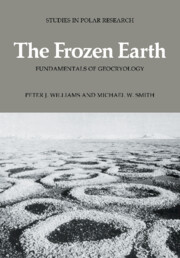Book contents
- Frontmatter
- Contents
- Symbols
- Preface
- Acknowledgements
- 1 PERIGLACIAL CONDITIONS
- 2 MORPHOLOGY OF PERMAFROST AND SEASONALLY FROZEN GROUND
- 3 CLIMATE AND FROZEN GROUND
- 4 THE GROUND THERMAL REGIME
- 5 THE FORMS OF THE GROUND SURFACE 1: SLOPES AND SUBSIDENCES
- 6 THE FORMS OF THE GROUND SURFACE 2: STRUCTURES AND MICROTOPOGRAPHY OF LEVEL GROUND
- 7 THERMODYNAMIC BEHAVIOUR OF FROZEN SOILS
- 8 HYDROLOGY OF FROZEN GROUND
- 9 THE MECHANICS OF FROZEN GROUND
- 10 GEOCRYOLOGY PAST AND FUTURE
- References
- Index
6 - THE FORMS OF THE GROUND SURFACE 2: STRUCTURES AND MICROTOPOGRAPHY OF LEVEL GROUND
Published online by Cambridge University Press: 24 October 2009
- Frontmatter
- Contents
- Symbols
- Preface
- Acknowledgements
- 1 PERIGLACIAL CONDITIONS
- 2 MORPHOLOGY OF PERMAFROST AND SEASONALLY FROZEN GROUND
- 3 CLIMATE AND FROZEN GROUND
- 4 THE GROUND THERMAL REGIME
- 5 THE FORMS OF THE GROUND SURFACE 1: SLOPES AND SUBSIDENCES
- 6 THE FORMS OF THE GROUND SURFACE 2: STRUCTURES AND MICROTOPOGRAPHY OF LEVEL GROUND
- 7 THERMODYNAMIC BEHAVIOUR OF FROZEN SOILS
- 8 HYDROLOGY OF FROZEN GROUND
- 9 THE MECHANICS OF FROZEN GROUND
- 10 GEOCRYOLOGY PAST AND FUTURE
- References
- Index
Summary
Surface characteristics
Explorers of the Arctic tundra regions in the nineteenth century were impressed by strange, orderly geometric formations on the surface of the ground. They came upon expanses of circles free of vegetation, upon fields of half-metre high hummocks ‘resembling flocks of resting sheep’, and sometimes on vast networks of boulders in interconnected circular or polygonal arrangements. The latter were on a scale that, on occasion, could conceivably have been man-made and sometimes were believed to be so. These structures, and others on a similar scale which were restricted to sloping ground, were striking and unique features of the tundra parts of the cold regions, as conspicuous as the treelessness itself. Many merely descriptive accounts of such patterned ground were published even well into this century. Troll (1944) listed some 1500 articles, and, although it was already obvious that freezing and thawing was responsible, the precise mechanisms were often obscure. A variety of theories, sometimes fanciful, had been developed, yet with little detail and little concrete evidence even of rates of formation let alone of the physical and mechanical processes involved.
Washburn (1956) developed a classification laying emphasis on geometric form, and whether sorting occurs to give accumulations of uniform grain size. In his more recent, well-illustrated review Washburn (1979) describes the geomorphological processes which may have a role in formation of patterned ground. There remain complex unanswered questions of mechanics and thermodynamics, however.
- Type
- Chapter
- Information
- The Frozen EarthFundamentals of Geocryology, pp. 149 - 173Publisher: Cambridge University PressPrint publication year: 1989



